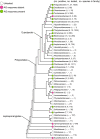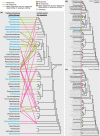Insights into the evolutionary history and widespread occurrence of antheridiogen systems in ferns
- PMID: 32740926
- PMCID: PMC7754499
- DOI: 10.1111/nph.16836
Insights into the evolutionary history and widespread occurrence of antheridiogen systems in ferns
Abstract
Sex expression of homosporous ferns is controlled by multiple factors, one being the antheridiogen system. Antheridiogens are pheromones released by sexually mature female fern gametophytes, turning nearby asexual gametophytes precociously male. Nevertheless, not all species respond. It is still unknown how many fern species use antheridiogens, how the antheridiogen system evolved, and whether it is affected by polyploidy and/or apomixis. We tested the response of 68 fern species to antheridiogens in cultivation. These results were combined with a comprehensive review of literature to form the largest dataset of antheridiogen interactions to date. Analyzed species also were coded as apomictic or sexual and diploid or polyploid. Our final dataset contains a total of 498 interactions involving 208 species (c. 2% of all ferns). About 65% of studied species respond to antheridiogen. Multiple antheridiogen types were delimited and their evolution is discussed. Antheridiogen responsiveness was not significantly affected by apomixis or polyploidy. Antheridiogens are widely used by ferns to direct sex expression. The antheridiogen system likely evolved multiple times and provides homosporous ferns with the benefits often associated with heterospory, such as increased rates of outcrossing. Despite expectations, antheridiogens may be beneficial to polyploids and apomicts.
Keywords: antheridiogen; apomixis; ferns; gametophyte; germination; mating; polyploidy; sex expression.
© 2020 The Authors New Phytologist © 2020 New Phytologist Trust.
Figures




References
-
- Bateman RM, DiMichele WA. 1944. Heterospory: the most iterative key innovation in the evolutionary history of the plant kingdom. Biological Reviews 69: 345–417.
-
- Bold HC. 1957. Morphology of plants. New York, NY, USA: Harper & Row.
-
- Chiou W‐L, Farrar DR. 1997. Antheridiogen production and response in Polypodiaceae species. American Journal of Botany 84: 633–640. - PubMed
Publication types
MeSH terms
LinkOut - more resources
Full Text Sources

